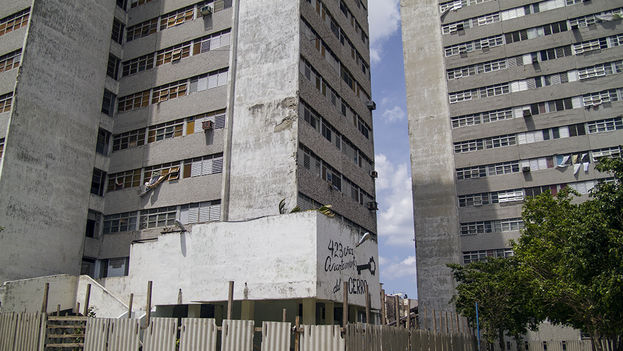
Havana, June 9, 2014, Victor Ariel Gonzalez — Corrugated fiber-cement sheets and wooden planks form a security fence in the shadow of the two tallest buildings of an iconic Havana site: the “Twin Towers” at Texas Corner, where 240 families live, marooned, as the buildings crumble.
Every day many people walk past, where the sidewalks of Calzada Del Cerro and Diez de Octubre intersect. Life goes on as usual at the foot of the gray structures, 20 floors and 200 feet high, which dangerously dominate the landscape.
A glance behind the makeshift wall leaves no doubt about the problem: chunks of rust-stained concrete detached from the walls are scattered in the grass, evidence of the deterioration of the buildings. If you look up, the poor state of the structural walls, which support thousands of tons, is revealed, with their broken edges and numerous areas where rebar is exposed.
The corrosion causes the metal framework inside the concrete to expand, creating pressure on the covering, cracking and loosening pieces. People say the concrete is “bursting.” This is inevitable in construction using low-quality materials or inadequate technology in the concrete-fabricating process. The phenomenon now affects both 20-story structures on Texas Corner.
An unpredictable and deadly shower of concrete hailstones weighing several pounds
With rust replacing metal, the reinforcing steel loses its structural strength, which is its sole purpose. The building weakens, significantly shortening its useful life. Those who inhabit the buildings are at risk, but not only them. Before the agency responsible for repairing properties extended the protective perimeter in October 2013, passersby were exposed to an unpredictable and deadly shower of concrete hailstones weighing several pounds.
Children play after school in the portion of the park remaining outside the fence. A neighbor, whose little granddaughter is running around there, recalls that construction of the towers was completed in 1992: “I myself participated in the work because during that time I was in the micro.” She is referring to the “microbrigades,” crews of unskilled laborers who built multifamily housing in exchange for a place to live. “They gave me an apartment here, but I’ve always had problems. The windows don’t keep the rain out.”
She remembers that the south tower was built entirely by prisoners, while the north was under the control of those who would be the future owners. In both cases, the work left much to be desired technically. “One time they came around collecting money to retouch the exterior bearing walls, but the people wouldn’t agree because the windows were going to stay the same and the problem was not really going to be solved.” That was several years ago.
Now emergency intervention is needed. But those who installed the fence in only a few days—supposedly the same ones who would repair the towers—have not continued the work, which has been postponed indefinitely. The residents have not been informed of a date for the work to be done. The months go by and the risk increases every day as the corrosion silently advances.
Translated by Tomás A.
